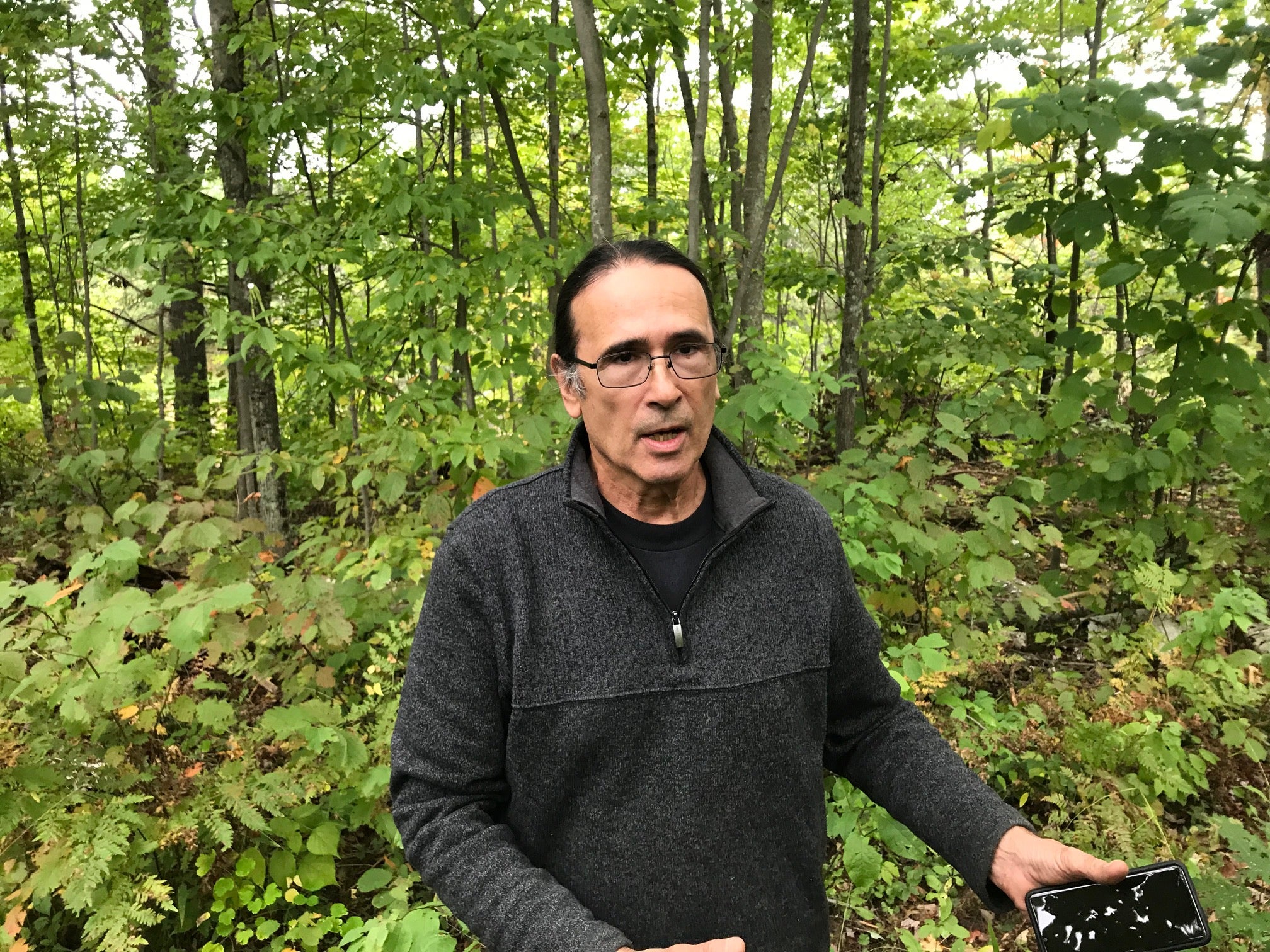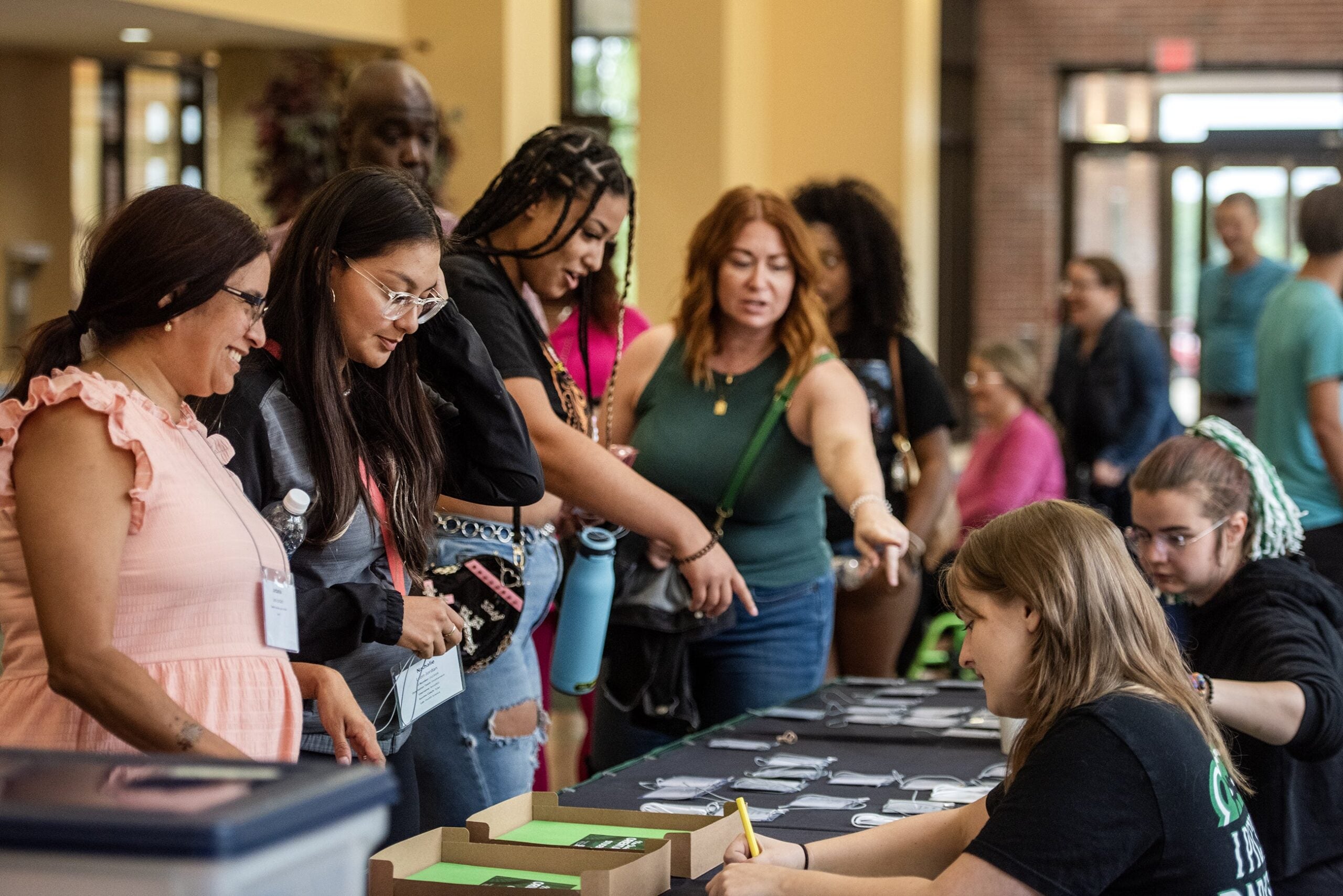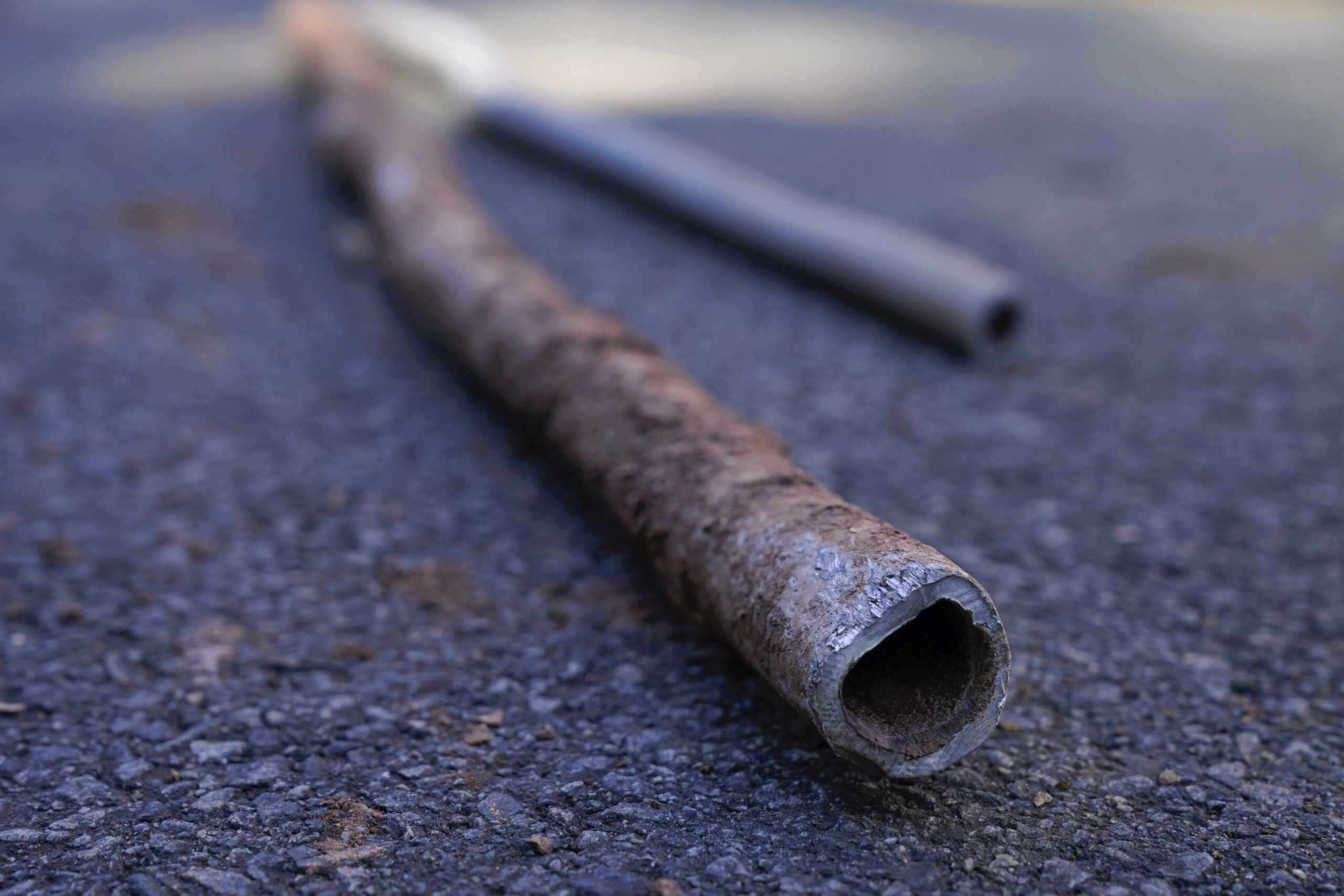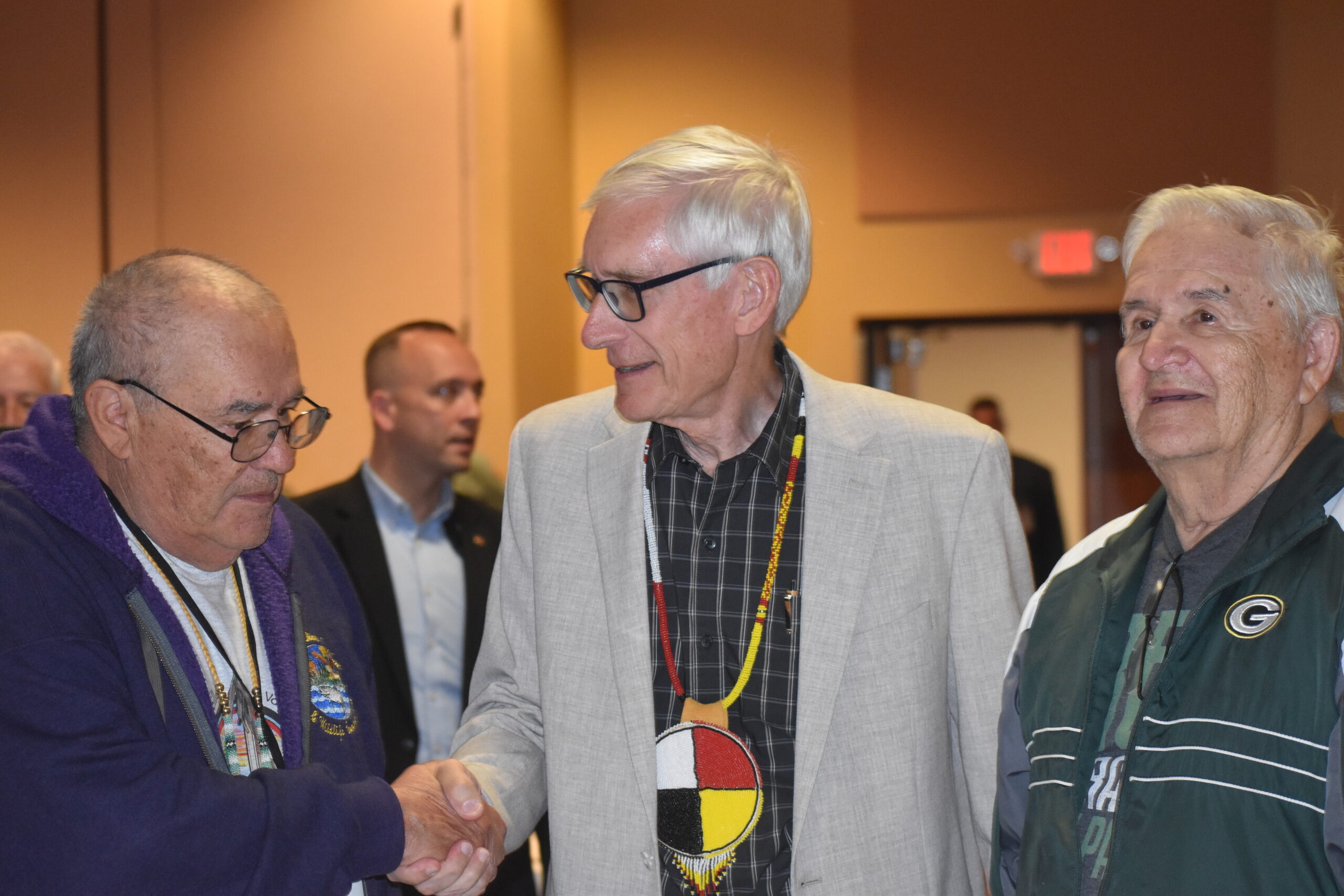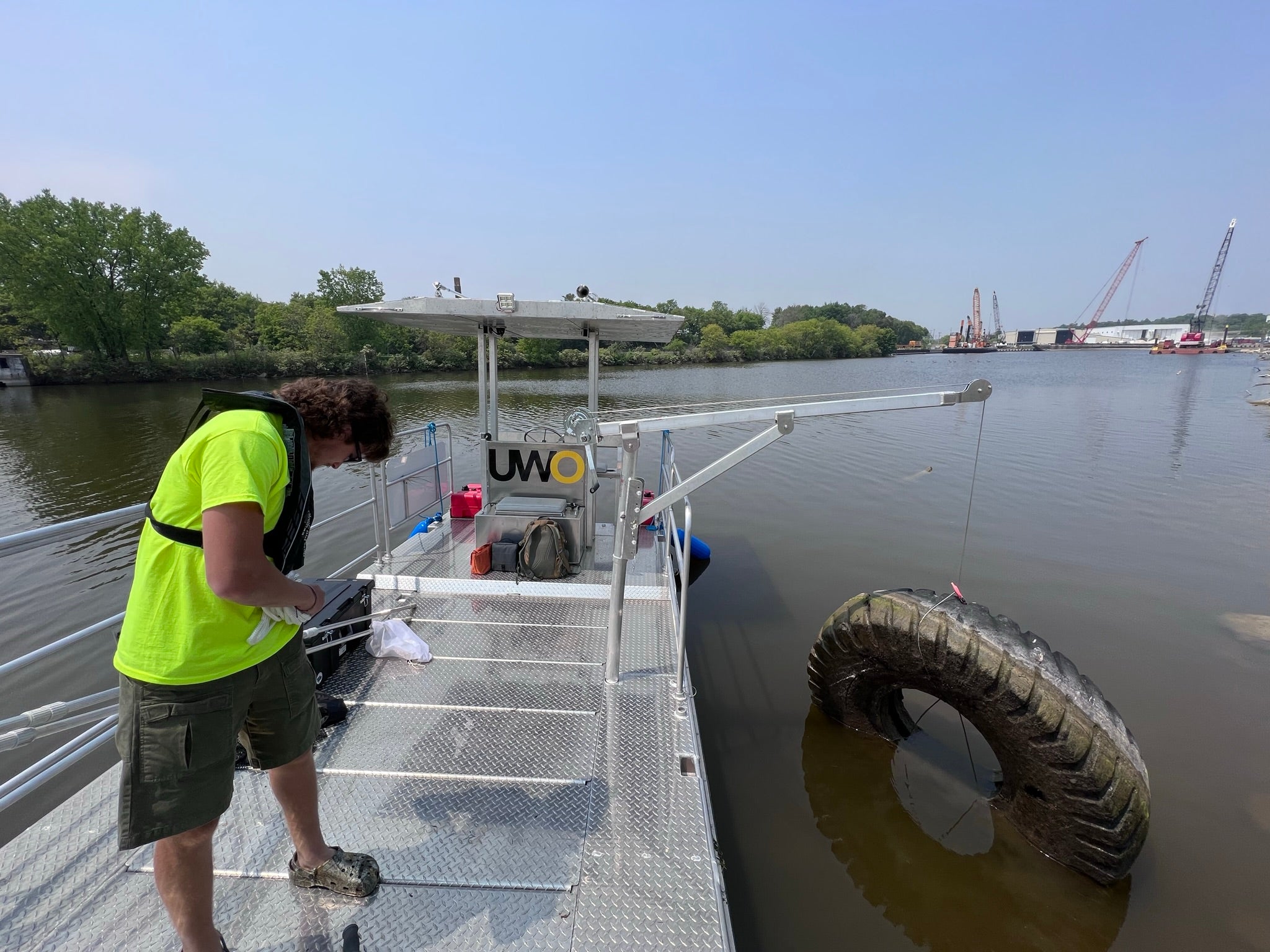Paul DeMain had been a journalist for about a year when the FBI came to serve search warrants on the chairman of the Lac Courte Oreilles tribe.
It was 1977. DeMain was in his early 20s and still new to the reservation. He’d been brought there by the tribal chairman to work as the communications director for the tribe and the editor of a new tribal newspaper, the Lac Courte Oreilles Journal American.
DeMain watched the FBI agents send those working in the office home for the day while they seized boxes of documents. He took a call from the chairman, his boss, who said he wanted to clear up “rumors” that there had been a raid. He told DeMain what to write in the press release for the Sawyer County Record.
Stay informed on the latest news
Sign up for WPR’s email newsletter.
“Blah blah blah blah blah,” DeMain summarized. “There are no FBI agents here. They are not confiscating documents. They are not serving search warrants.”
DeMain dutifully wrote and sent the press release.
“An hour later,” he said, “I sent a second news story out, describing how the police had arrived at 11:25 a.m. and served a search warrant on the tribal government, and (FBI agents) were taking documents and records” from the chairman’s office.
The moral of the story, as DeMain tells it now: “That’s the difference between a public relations employee and a newspaper editor.”
DeMain made for a lousy public relations employee, but he became a great newspaper editor.
He would spend decades as one of the most prolific and important Native American journalists in the country. He would cover tribal news across the country, and break a series of stories relating to 1970s radical Leonard Peltier that challenged some deeply held loyalties. Now DeMain is at the end of his career as a newspaper publisher, and a crossroads in his life.
The 1977 FBI raid would lead to tribal chairman Odric Baker’s forced resignation the next year. DeMain would stay on with the tribal newspaper until 1983, when he’d go to Madison to serve as tribal liaison in the administration of Wisconsin Gov. Tony Earl.
Returning to Sawyer County in 1986, he would launch the News from Indian Country, an independent Native American newspaper that would grow to become one of a small handful of Native outlets with national and international reach.
For a time his company Indian Country Communications — which published the newspaper as well as special publications, a website and an internet news broadcast — would be one of the largest employers on the Lac Courte Oreilles reservation.
In August, DeMain published the newspaper’s last issue. The publication saw the same declines in revenue suffered by the mainstream newspaper industry. It would have been possible to continue publishing for a few more years, DeMain said, but the trajectory was unmistakable. Its loss is a blow to independent, Native American-owned media.
But at 64, DeMain is ready for his own next chapter.
[[{“fid”:”1076861″,”view_mode”:”full_width”,”fields”:{“alt”:”Paul DeMain”,”title”:”Paul DeMain”,”class”:”media-element file-full-width”,”data-delta”:”2″,”format”:”full_width”,”alignment”:””,”field_image_caption[und][0][value]”:”%3Cp%3EIn%20the%20former%20offices%20of%20News%20from%20Indian%20Country%2C%20Paul%20DeMain%20shows%20the%20final%20print%20edition%20of%20the%20newspaper%2C%20which%20ran%20for%2033%20years.%20%3Cem%3ERob%20Mentzer%2FWPR%3C%2Fem%3E%3C%2Fp%3E%0A”,”field_image_caption[und][0][format]”:”full_html”,”field_file_image_alt_text[und][0][value]”:”Paul DeMain in the former offices of News from Indian Country”,”field_file_image_title_text[und][0][value]”:”Paul DeMain in the former offices of News from Indian Country”},”type”:”media”,”field_deltas”:{“2”:{“alt”:”Paul DeMain”,”title”:”Paul DeMain”,”class”:”media-element file-full-width”,”data-delta”:”2″,”format”:”full_width”,”alignment”:””,”field_image_caption[und][0][value]”:”%3Cp%3EIn%20the%20former%20offices%20of%20News%20from%20Indian%20Country%2C%20Paul%20DeMain%20shows%20the%20final%20print%20edition%20of%20the%20newspaper%2C%20which%20ran%20for%2033%20years.%20%3Cem%3ERob%20Mentzer%2FWPR%3C%2Fem%3E%3C%2Fp%3E%0A”,”field_image_caption[und][0][format]”:”full_html”,”field_file_image_alt_text[und][0][value]”:”Paul DeMain in the former offices of News from Indian Country”,”field_file_image_title_text[und][0][value]”:”Paul DeMain in the former offices of News from Indian Country”}},”link_text”:false,”attributes”:{“alt”:”Paul DeMain in the former offices of News from Indian Country”,”title”:”Paul DeMain in the former offices of News from Indian Country”,”class”:”media-element file-full-width”,”data-delta”:”2″}}]]
News From Indian Country Was An Independent Voice
DeMain was born in 1955 in Milwaukee. When he was very young, he was adopted by a family in Wausau.
Growing up on Wausau’s west side, he knew all the Native American families in central Wisconsin, though his own adoptive parents were white, and he sought out connections to his Ojibwe heritage. In high school, he became passionate about journalism. And when, in 1973, activists from the radical American Indian Movement occupied the town of Wounded Knee in South Dakota, he read everything he could about the conflict.
“I was looking at the Associated Press stories that were appearing in short little columns, 2- or 3-column inches,” DeMain said. They reported, more or less, “a bunch of radical Indians took over Wounded Knee and were making demands of the U.S. government,” he said.
Contrast that with what he learned in a Native publication called Akwesasne Notes, which offered full-length articles rich in context and history, reflecting complexities within the Native community itself in addition to reporting on the conflict between the American Indian Movement, known as AIM, and the U.S. government.
“Looking at the difference, I thought, if I had the chance, what I ought to do is give voice to the Native community,” DeMain said.
The News from Indian Country would provide a digest of stories about Native American communities from coast to coast and beyond, including stories from indigenous communities across Canada, in New Zealand and elsewhere.
[[{“fid”:”1076911″,”view_mode”:”full_width”,”fields”:{“format”:”full_width”,”alignment”:””,”field_image_caption[und][0][value]”:”%3Cp%3EThe%20former%20offices%20of%20News%20from%20Indian%20Country%2C%20on%20the%20lower%20level%20of%20this%20building%2C%20are%20vacant%20today.%20The%20offices%20were%20on%20the%20Lac%20Courte%20Oreilles%20reservation%20in%20Sawyer%20County.%20%3Cem%3ERob%20Mentzer%2FWPR%3C%2Fem%3E%3C%2Fp%3E%0A”,”field_image_caption[und][0][format]”:”full_html”,”field_file_image_alt_text[und][0][value]”:”former offices of News from Indian Country,”,”field_file_image_title_text[und][0][value]”:”former offices of News from Indian Country,”},”type”:”media”,”field_deltas”:{“5”:{“format”:”full_width”,”alignment”:””,”field_image_caption[und][0][value]”:”%3Cp%3EThe%20former%20offices%20of%20News%20from%20Indian%20Country%2C%20on%20the%20lower%20level%20of%20this%20building%2C%20are%20vacant%20today.%20The%20offices%20were%20on%20the%20Lac%20Courte%20Oreilles%20reservation%20in%20Sawyer%20County.%20%3Cem%3ERob%20Mentzer%2FWPR%3C%2Fem%3E%3C%2Fp%3E%0A”,”field_image_caption[und][0][format]”:”full_html”,”field_file_image_alt_text[und][0][value]”:”former offices of News from Indian Country,”,”field_file_image_title_text[und][0][value]”:”former offices of News from Indian Country,”}},”link_text”:false,”attributes”:{“alt”:”former offices of News from Indian Country,”,”title”:”former offices of News from Indian Country,”,”class”:”media-element file-full-width”,”data-delta”:”5″}}]]
Patty Loew, a longtime broadcast journalist in Wisconsin who now heads the Center for Native American and Indigenous Research at Northwestern University, said its work helped to show common threads and common challenges among these disparate indigenous communities.
“I would have to read a thousand copies of the New York Times or the Washington Post in order to get the concentrated number of indigenous-related stories” that came in an issue of News from Indian Country, Loew said.
With News from Indian Country now shuttered, there remains one major national outlet focused on Native news.
Indian Country Today started as a weekly newspaper in 1981, The Lakota Times. Since turning to an online, national approach in the 1990s, it’s had several iterations and ownership changes. It closed in 2017, but relaunched in 2018 after the Oneida Nation of New York donated it to the National Congress of American Indians. It’s now operating on a nonprofit news model. Its editor, Mark Trahant, said it exists through a combination of grants, memberships and other income sources.
Trahant has known and worked with DeMain for years. He said DeMain’s independence always sets him apart.
“(DeMain) saw this idea of being able to be independent by being private,” Trahant said, as opposed to being the product of a particular tribe or nation. “That vision, I think, was really extraordinary.”
Investigation Into Peltier Overturned Assumptions
Anna Mae Pictou Aquash was 30 years old in 1976 when she was shot and killed on the Pine Ridge Indian Reservation in South Dakota. She’d been active with the American Indian Movement, and was having an affair with one of AIM’s leaders, Dennis Banks. Another AIM leader, Leonard Peltier, had been arrested in Canada just weeks before on charges that he killed two FBI agents during a 1975 shootout at Pine Ridge.
Peltier would be convicted, though questions around his trial persist.
No one would be charged in Aquash’s death for decades.
[[{“fid”:”1076856″,”view_mode”:”full_width”,”fields”:{“format”:”full_width”,”alignment”:””,”field_image_caption[und][0][value]”:”%3Cp%3ERebecca%20Julian%2C%20left%2C%20Anna%20Mae%20Pictou%20Aquash’s%20eldest%20sister%2C%20and%20Aquash’s%20eldest%20daughter%2C%20Denise%20Maloney%2C%20hold%20a%20portrait%20of%20Aquash%20Sunday%2C%20June%2020%2C%202003%2C%20at%20Shubenacadie%2C%20Nova%20Scotia.%20%3Cem%3ECarson%20Walker%2FAP%20Photo%3C%2Fem%3E%3C%2Fp%3E%0A”,”field_image_caption[und][0][format]”:”full_html”,”field_file_image_alt_text[und][0][value]”:”Rebecca Julian, left, Anna Mae Pictou Aquash’s eldest sister, and Aquash’s eldest daughter, Denise Maloney,”,”field_file_image_title_text[und][0][value]”:”Rebecca Julian, left, Anna Mae Pictou Aquash’s eldest sister, and Aquash’s eldest daughter, Denise Maloney,”},”type”:”media”,”field_deltas”:{“1”:{“format”:”full_width”,”alignment”:””,”field_image_caption[und][0][value]”:”%3Cp%3ERebecca%20Julian%2C%20left%2C%20Anna%20Mae%20Pictou%20Aquash’s%20eldest%20sister%2C%20and%20Aquash’s%20eldest%20daughter%2C%20Denise%20Maloney%2C%20hold%20a%20portrait%20of%20Aquash%20Sunday%2C%20June%2020%2C%202003%2C%20at%20Shubenacadie%2C%20Nova%20Scotia.%20%3Cem%3ECarson%20Walker%2FAP%20Photo%3C%2Fem%3E%3C%2Fp%3E%0A”,”field_image_caption[und][0][format]”:”full_html”,”field_file_image_alt_text[und][0][value]”:”Rebecca Julian, left, Anna Mae Pictou Aquash’s eldest sister, and Aquash’s eldest daughter, Denise Maloney,”,”field_file_image_title_text[und][0][value]”:”Rebecca Julian, left, Anna Mae Pictou Aquash’s eldest sister, and Aquash’s eldest daughter, Denise Maloney,”}},”link_text”:false,”attributes”:{“alt”:”Rebecca Julian, left, Anna Mae Pictou Aquash’s eldest sister, and Aquash’s eldest daughter, Denise Maloney,”,”title”:”Rebecca Julian, left, Anna Mae Pictou Aquash’s eldest sister, and Aquash’s eldest daughter, Denise Maloney,”,”class”:”media-element file-full-width”,”data-delta”:”1″}}]]
When DeMain was in high school, the radicals of AIM had a romantic appeal — the “headbands and feathers and sunglasses,” he said, as well as the message of resistance, of Native rights. The movement, founded in Minneapolis in 1968, bore some similarities to the Black Panther Party or other left-wing militant groups of the 1960s.
For decades, Peltier was a cause célèbre throughout the Native community and across like-minded groups. News from Indian Country published stories about the case, about fundraisers for Peltier’s legal defense, about celebrities who lent their support.
“The idea that Peltier was an innocent man was almost a universal feeling at some point,” DeMain said.
By contrast, not many people outside of a few circles in the Native community people spared a thought for Aquash. To the extent anyone did think of her, many of them blamed her death, like Peltier’s conviction, on the FBI.
In early 2001, Banks’ ex-wife, Ka-Mook Nichols, visited DeMain on the Lac Courte Oreilles reservation. She had moved multiple times, in part out of fear of AIM members. She would meet him in Denver six months later for a lengthy interview. Nichols knew DeMain’s reputation as a journalist. And she knew things about both Peltier and Aquash.
DeMain worked with fellow Native journalists Richard LaCourse and Minnie Two Shoes to track down multiple sources who had heard Peltier brag about killing the two FBI agents.
LaCourse, a member of the Yakama nation who lived in eastern Washington state, was the first news director of the American Indian Press Association, and has been called the dean of American Indian journalism. He died in 2001, as the story was still coming together. Two Shoes, a member of the Assiniboine Sioux nation, had been a publicist for AIM in the early 1970s before becoming a journalist. She knew Aquash personally. Two Shoes died in 2010.
Together, the three journalists spoke to countless sources, reviewed documents compiled by the U.S. Department of Justice. In January 2002, they published evidence that not only had Peltier bragged to Aquash about shooting the two agents, but also that it was that conversation that led others within AIM to kill her in order to protect Peltier.
[[{“fid”:”1076886″,”view_mode”:”embed_portrait”,”fields”:{“format”:”embed_portrait”,”alignment”:”right”,”field_image_caption[und][0][value]”:”%3Cp%3EPaul%20DeMain%20holds%20a%20picture%20of%20James%20%22Pipe%22%20Mustache%2C%20who%20was%20a%20Lac%20Courte%20Oreilles%20elder%20and%20a%20mentor%20to%20DeMain%20in%20the%20years%20after%20DeMain%20came%20to%20the%20reservation.%20%3Cem%3ERob%20Mentzer%2FWPR%3C%2Fem%3E%3C%2Fp%3E%0A”,”field_image_caption[und][0][format]”:”full_html”,”field_file_image_alt_text[und][0][value]”:”Paul DeMain holds a picture of James \”Pipe\” Mustache”,”field_file_image_title_text[und][0][value]”:”Paul DeMain holds a picture of James \”Pipe\” Mustache”},”type”:”media”,”field_deltas”:{“3”:{“format”:”embed_portrait”,”alignment”:”right”,”field_image_caption[und][0][value]”:”%3Cp%3EPaul%20DeMain%20holds%20a%20picture%20of%20James%20%22Pipe%22%20Mustache%2C%20who%20was%20a%20Lac%20Courte%20Oreilles%20elder%20and%20a%20mentor%20to%20DeMain%20in%20the%20years%20after%20DeMain%20came%20to%20the%20reservation.%20%3Cem%3ERob%20Mentzer%2FWPR%3C%2Fem%3E%3C%2Fp%3E%0A”,”field_image_caption[und][0][format]”:”full_html”,”field_file_image_alt_text[und][0][value]”:”Paul DeMain holds a picture of James \”Pipe\” Mustache”,”field_file_image_title_text[und][0][value]”:”Paul DeMain holds a picture of James \”Pipe\” Mustache”}},”link_text”:false,”attributes”:{“alt”:”Paul DeMain holds a picture of James \”Pipe\” Mustache”,”title”:”Paul DeMain holds a picture of James \”Pipe\” Mustache”,”class”:”media-element file-embed-portrait media-wysiwyg-align-right”,”data-delta”:”3″}}]]DeMain’s reporting would spur new investigations into Aquash’s death, including the convictions of two AIM members found to have been tangentially involved. It would also change the way many saw Peltier.
DeMain’s Ojibwe name is Skabewis, which means “The Messenger.” He got it from a mentor, the Lac Courte Oreilles elder James “Pipe” Mustache, for whom DeMain served as a driver for years after he came to the reservation, chauffeuring him to ceremonial functions and meeting many tribal leaders and elders in the process. It was an experience that helped define DeMain, and he still thinks often about how he can serve as a messenger to his community.
When it came to Peltier, DeMain said, “I brought a message that nobody wanted to hear.”
But maybe, he adds, no one would have listened if it had come from someone else.
In Search Of Mushrooms, And Life Without Newspaper Deadlines
These days, one of DeMain’s chief interests is mushrooms. Their medicinal properties haven’t been fully unlocked, he said.
“I think if they’re studied, maybe the cure for cancer, or maybe the cure for, I don’t know, some kind of ailment, like Trumpism, could be found in the mushrooms,” he deadpanned.
DeMain is not shy about his left-wing politics. He was a fan of Bernie Sanders in the Democratic presidential primary in 2016, and he ran for state Senate himself as a Democrat in 2014.
“Curing” Trumpism is a joke, but the care for mushrooms is real.
DeMain is spending time on his land, cataloging what he has. He collects chaga mushrooms, which grow on birch, and crushes them into a pulpy substance that some say has medicinal qualities. He’s cut some long logs, drilled holes in them and inoculated them with mushroom spawn — summer white oyster, shiitake, lion’s mane — sealed over with wax. With any luck, they’ll make for tasty soups next spring.
DeMain hopes to earn some money in his new life from mushrooms, maple vinegar and other products of the woods.
He also plans to do some freelance journalism — Trahant hopes to work with him at Indian Country Today — and he earns money from occasional speaking engagements.
But there’s also a political reason behind his interest in the food sources found on his land. He’s taken an interest in the “food sovereignty” movement, which is about helping tribal communities connect with healthy, local foods. Through the cultivation of foods traditionally harvested by indigenous people, he said he hopes people learn to connect, too, with their history.
“We have a generation of young people who know how to go buy their food at Walmart and warm it up in the microwave,” DeMain said.
An appreciation of the land, its natural rhythms and growing seasons, is one way to start to reverse that.
“We’re recovering our mental health, we’re recovering our history, we’re recovering our food, we’re recovering our pride at every level,” DeMain said. “And it may be that the indigenous community is going to be a key to the survival of mankind in the future.”
On an overcast day at the end of September, DeMain takes a delivery of chaga mushrooms to an elder on the reservation, 84-year-old Sandy Bird. She offers to pay him, and they settle on plans for her to bake him a blueberry pie instead. In her living room, they chat about politics. The governor will be visiting a tribal celebration.
“That’ll be good,” Bird says. “I think he’s for the Indians.”
“He’s been out and about quite a bit,” DeMain agrees.
There’s a pipeline protest he’s going to attend in the Superior area. There’s a Treaty Day celebration on Madeline Island, where Ojibwe people once played massive games of lacrosse. And he’s sorting through the boxes and records of 33 years of News from Indian Country. There’s no shortage of things to do.
But he’s also adjusting to life without newspaper deadlines. He’s able to pick up his grandkids from school, and to spend time on his land. His life has a different rhythm.
“I was anxious about money, anxious about shutting the business down, anxious about a lot of things,” DeMain said. “The answer is to really try to live each day as it comes. I’ve got food, shelter, people who love me. I’m OK. Let’s get through today, and live it to the best.”
Wisconsin Public Radio, © Copyright 2024, Board of Regents of the University of Wisconsin System and Wisconsin Educational Communications Board.

